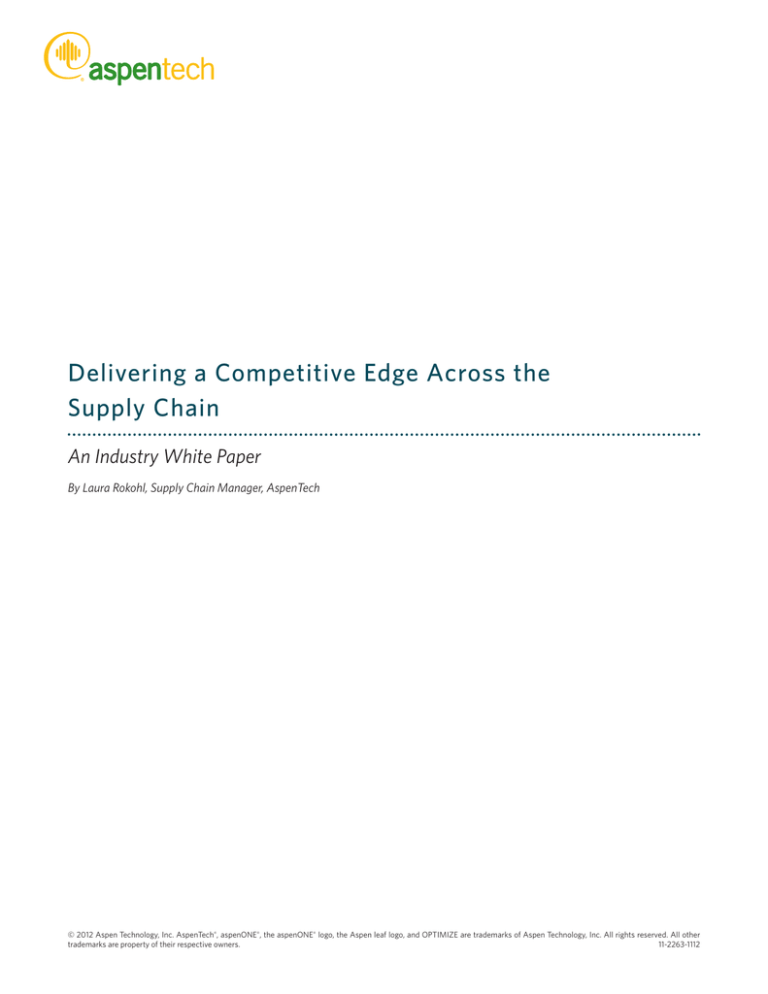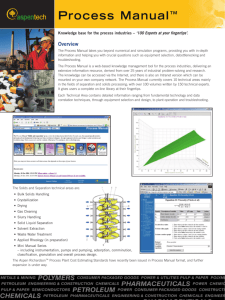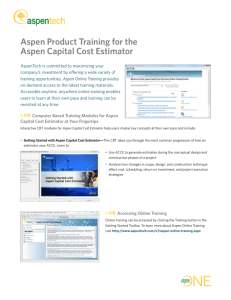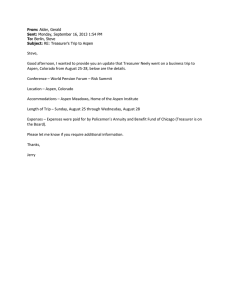
Delivering a Competitive Edge Across the
Supply Chain
An Industry White Paper
By Laura Rokohl, Supply Chain Manager, AspenTech
© 2012 Aspen Technology, Inc. AspenTech®, aspenONE®, the aspenONE® logo, the Aspen leaf logo, and OPTIMIZE are trademarks of Aspen Technology, Inc. All rights reserved. All other
trademarks are property of their respective owners.
11-2263-1112
Delivering a Competitive Edge Across the Supply Chain
© 2012 Aspen Technology, Inc. AspenTech®, aspenONE®, the aspenONE® logo, the Aspen leaf logo, and OPTIMIZE are trademarks of Aspen Technology, Inc. All rights reserved. All other
trademarks are property of their respective owners.
11-2263-1112
Delivering a Competitive Edge Across the Supply Chain
Supply chain leaders face significant challenges today amidst market volatility and growing competition. Success across
the supply chain relies upon having an effective integrated strategy between planning and scheduling in order to remain
profitable and to be able to meet customer demand. To achieve this goal, investment in technology is a vital step to
successfully modelling, visualizing, analyzing, monitoring, and reporting across the supply chain network.
Demand managers, planners, and schedulers play a vital role in delivering products to market, taking into account market
demand, current inventories and operational constraints. The chemicals industry alone produces over 70,000 diverse
products from acetyls to zirconium chemicals. The pharmaceutical industry has multi-product concurrent manufacturing,
with intricate timing of production activities and equipment, such as clean-in-place skids that must be shared across
assets. The consumer goods industry is characterized by rapidly changing consumer preferences, growth in emerging
geographies, and volatile market conditions. While the specific business challenges may differ across all process
industries, there is strong pressure to improve operational agility, reduce costs, maximize output, accelerate products to
market, and meet compliance mandates while delivering high levels of customer service.
Companies must find a way to meet demand despite volatility in energy, operating and feedstock costs, plant utilization
rates at near capacity levels and the need to keep inventory costs at acceptable levels. At the same time, many chemical
companies are also facing demands for higher performance at lower environmental risk and they have to deal with a
mature commoditized industry characterised by high volume, low margin and the increasing globalization of markets. If
they are to effectively manage these challenges, companies across the supply chain need to find a way to closely integrate
functions like forecasting, planning and scheduling. Integration is vital to drive efficiencies, enhance productivity and,
ultimately, achieve a competitive edge.
All supply chains from the simplest to the most intricate constantly
look to achieve streamlined operational efficiency. In doing so, they
face a range of issues, such as a wide array of products with different
manufacturing methods. Each will have different bills of materials,
product grades and specifications that must be represented and
managed as part of the manufacturing process.
A key supply chain area where businesses often struggle is having
sufficient agility to react quickly to sudden shifts in the business or
market environment. When a change, incident, or unexpected event
occurs, awareness and action must follow immediately.
While these unexpected events can come in many different forms, they
typically fall into three distinct categories. The first is around
operational upsets. An example of this is an equipment failure — when
a system or application stops working, for example, bringing
production to a halt. The second category is an environmental disaster — flooding, tsunami, hurricanes, for example —
that could potentially disrupt the supply chain, logistics and raw material supply in particular. The third key area is
unexpected customer orders where companies need to weigh the pros and cons of disrupting the rest of their production
operations in order to accommodate the opportunity to fulfill a lucrative order with a top tier customer.
© 2012 Aspen Technology, Inc. AspenTech®, aspenONE®, the aspenONE® logo, the Aspen leaf logo, and OPTIMIZE are trademarks of Aspen Technology, Inc. All rights reserved. All other
trademarks are property of their respective owners.
11-2263-1112
1
Delivering a Competitive Edge Across the Supply Chain
The Key Role of Forecasting and Planning
For companies across the supply chain, success in meeting these challenges will largely rely on their ability to deliver
efficient business processes and seamless integration between business functions. Most chemicals companies generate
forecasts of predicted sales over a 12-18 month time frame — typically in monthly time schedules. That information then
gets fed to the planning function. In a perfect world, these companies would like to always fulfill the demand and meet
their forecasts. The planning model brings them back to reality as it creates an optimal production plan based on the
assets that they have, the number of locations and corresponding capacity and the most cost effective way to store and
transport material. Planning in this context is typically a part of Sales and Operational Planning (S&OP) — the process of
aligning demand and supply to drive a business outcome. Businesses across the chemicals supply chain need to look at
how they can most profitably meet customer demand while at the same time help drive operational agility.
With the flexibility and degrees of freedom built into today’s global supply chain, decision-makers often have the ‘luxury’
of being able to choose from several different options with regard to which plant location will fulfill customer demand.
They may need to take into account transportation times and costs, for example, before deciding between sourcing
product out of Europe, China, or the United States. Competing effectively in today’s process industries requires a
fundamental shift from supply push to demand pull (essentially manufacturing to demand which delivers improved
margins and higher levels of customer satisfaction). A recent white paper, The Evolution of Optimization in Process
Industries, written by Pierfrancesco Manenti, Head — Europe, Middle East & Africa, IDC Manufacturing Insights,
recommends to companies that have asset oriented value chains (AOVCs as the paper describes) to “rethink your supply
chain structure to transform it into demand pull versus supply push, essentially manufacturing to demand, which offers
better margins and higher levels of customer satisfaction.” This requires AOVCs to consider plants and assets as nodes in
the global supply chain. This need is being driven by the requirement to engage more closely with customers and provide
better service in an environment where they have more supply choice. As a result, manufacturers must compete not just
on product quality, but also on how effectively they deliver what customers are seeking. Indeed, the IDC white paper finds
that the most critical capability for a globally integrated asset-oriented firm is “its ability to optimize the global network of
production assets dynamically to fulfill customer demand in the face of extremely dynamic business conditions”.
The Importance of Visibility
Visibility is very important to planning. Planners need to have
an excellent overview of what is happening not just in a single
plant, but across a network of plants. Having a high level of
awareness across the supply chain, balanced with the needs of
the business, will help at a regional and global level. It is crucial
for chemical companies to be clear about the problems within
individual plants and make them transparent to others within
their organization
In this context, being able to proactively look ahead is vital.
Planners need to ask themselves — “will we have raw material
supply five months from now?” and “do we need to order now to avoid a shortage?” Another key area of focus should be
around inventory storage. Ideally, planners will be looking to ensure products are manufactured just in time to be shipped,
so as not only to drive agility, but also to avoid the product using up limited storage space for an extended period and
© 2012 Aspen Technology, Inc. AspenTech®, aspenONE®, the aspenONE® logo, the Aspen leaf logo, and OPTIMIZE are trademarks of Aspen Technology, Inc. All rights reserved. All other
trademarks are property of their respective owners.
11-2263-1112
2
Delivering a Competitive Edge Across the Supply Chain
incurring inventory holding costs. At the same time, planners must find ways in which they can improve the business
process by delivering a framework for cost reduction and service improvement. They also need to be focused on improving
user productivity by facilitating quick analysis and decision-making through clear, visible and understandable reporting.
The Link to Scheduling
The long-term plan for the supply chain needs to integrate with the overall budget and business strategy. While planning
works to a 12-18 month time horizon, scheduling works to a much tighter timeframe — typically 3 months at the longest.
In an ideal scenario, schedulers should work to the inventory target guidelines provided by the planners, but they will also
need to react to immediate needs and changes in the plant and be agile enough to spot opportunities and act fast for the
benefit of the plant.
Schedulers typically receive an updated ‘snapshot’ — either nightly or on demand — of information that specifies what
has been produced, the actual inventory positions and whether there are new orders. Once the model has been updated
with the latest information, the scheduler will generally adjust it to resolve inventory problems, avoid late shipments and
bring in ad hoc production opportunities. The schedule keeps track of all of those changes and maps them back to the
system of record, typically the ERP. In practical operational terms, there are a host of challenges associated with
scheduling across the supply chain. While schedulers typically have intimate knowledge of their business and
manufacturing process, they need help in balancing the thousands of competing constraints that must be considered
when developing the best schedule. It is crucial that schedulers have technology at their disposal that enables them to
visualize potential schedule conflicts and provide guidance on how to analyze and resolve them as quickly as possible.
The other big issue is that while many companies are successful at achieving tightly coupled integration between
scheduling and the ERP system, data integration between scheduling and planning remains generally poor in some
organizations. According to a market study of the specialty chemicals industry conducted by AspenTech in 2011,
information passed between the planning and scheduling functions is largely manual and underutilized. This is largely the
result of business function silos, which create a ‘disconnect’ between supply chain planning and schedule execution. The
value of integration is to align business processes, providing the ability to evaluate multiple scenarios for constrained
production lines to optimize assets and maximize earning potential.
Finding a Solution
In overcoming these supply chain issues, companies should above all look for solutions that enable them to develop
integrated, optimized plans and schedules with the agility to respond to market opportunities as they arise. To deliver
competitive edge in this area, they need to increase operational efficiency and the best way to achieve that is through
solutions that support improved planning and scheduling of the production and distribution process. Many companies
have turned to AspenTech, a leading provider of process industry software, to help tackle inefficiencies end-to-end
throughout their engineering, manufacturing, and supply chain processes.
Ease-of-use is also important here. The simple, straightforward user interfaces offered by AspenTech’s supply chain
solutions, for example, provide fast access to information that can expedite profitable responses to unexpected market
demands and opportunities, which is becoming a necessity in an increasingly competitive marketplace. For planners and
schedulers who may have little formal supply chain training, software ease-of-use is invaluable not just in enabling users
to carry out their work effectively and in helping the company to become more agile, but also in ensuring the software
tools can help to make more informed decisions rather than using traditional spreadsheets.
© 2012 Aspen Technology, Inc. AspenTech®, aspenONE®, the aspenONE® logo, the Aspen leaf logo, and OPTIMIZE are trademarks of Aspen Technology, Inc. All rights reserved. All other
trademarks are property of their respective owners.
11-2263-1112
3
Delivering a Competitive Edge Across the Supply Chain
Figure 1: Simplify the identification and resolution of limiting constraints through the
use of analysis tools in Aspen Supply Chain Planner.
Critically, supply chain software solutions are capable of maximizing supply chain agility by constantly balancing supply
and demand on an enterprise-wide scale based on dynamic market conditions. Therefore , in meeting the raft of
challenges presented by today’s global supply chains, companies need to find a way of driving operational efficiencies,
agility and competitive edge whether they are operating relatively simple or extremely complicated supply chains. Today,
the latest breed of high-performance supply chain software solutions are being adopted by many of the leading chemicals
companies across sector.
As these organizations seek to improve their assets, a truly integrated asset-oriented company today will have the ability
to optimize its global network of production assets dynamically to fulfill customer demand with changing business
conditions. Ultimately, improved operational performance will lead to faster response to market opportunities and
increased margins across the value chain.
© 2012 Aspen Technology, Inc. AspenTech®, aspenONE®, the aspenONE® logo, the Aspen leaf logo, and OPTIMIZE are trademarks of Aspen Technology, Inc. All rights reserved. All other
trademarks are property of their respective owners.
11-2263-1112
4
Delivering a Competitive Edge Across the Supply Chain
Remaining Competitive
Supply chain leaders in the process industries are constantly seeking ways to drive better business results from their
supply chain processes. High forecast error due to market volatility and large infrequent orders are just a few of the
barriers to improve supply chain performance. Good visibility and supply agility will enable improved insights into the
most profitable options for fulfilling demand. Crucially, supply planning must enable and connect to scheduling at the
operating level.
Cultural issues around silo work-patterns need to be consigned to the past and they must demonstrate the commitment
to operate with greater collaboration and integration — people, processes and technology. Equipping staff with leadingedge software will help to provide the appropriate tools to maximize skills and overcome critical obstacles within the
operation — dynamically and efficiently. Such software tools provide an integrated solution set that tackles inefficiencies
end-to-end throughout engineering, planning and scheduling and plant operations processes. Companies deploying
dedicated software tools for chemicals are able to generate benefits of millions of dollars per year, per plant with payback
in months instead of years. Better alignment of processes and equipment from the plant floor through to executive
decision-making levels will also provide the ability to distribute, visualize and analyze information more intelligently.
Process manufacturers must increase the alignment of their supply chain practices to maximize opportunities in the
market. The transition to a demand-driven business model is an essential foundation from which process manufacturers
can launch a more transaction-oriented and astute approach to their business. The short-term prize is profit and
optimization — the long-term reward is market competitiveness and commercial sustainability across the supply chain.
© 2012 Aspen Technology, Inc. AspenTech®, aspenONE®, the aspenONE® logo, the Aspen leaf logo, and OPTIMIZE are trademarks of Aspen Technology, Inc. All rights reserved. All other
trademarks are property of their respective owners.
11-2263-1112
5
About AspenTech
AspenTech is a leading supplier of software that optimizes process manufacturing—for energy, chemicals,
pharmaceuticals, engineering and construction, power & utilities, mining, pulp and paper, and other mill
products industries that manufacture and produce products from a chemical process. With integrated
aspenONE® solutions, process manufacturers can implement best practices for optimizing their
engineering, manufacturing, and supply chain operations. As a result, AspenTech customers are better
able to increase capacity, improve margins, reduce costs, and become more energy efficient. To see how
the world’s leading process manufacturers rely on AspenTech to achieve their operational excellence
goals, visit www.aspentech.com.
Worldwide Headquarters
Aspen Technology, Inc.
200 Wheeler Road
Burlington, MA 01803
United States
phone: +1–781–221–6400
fax: +1–781–221–6410
info@aspentech.com
Regional Headquarters
Houston, TX | USA
phone: +1–281–584–1000
São Paulo | Brazil
phone: +55–11–3443–6261
Reading | United Kingdom
phone: +44–(0)–1189–226400
Singapore | Republic of Singapore
phone: +65–6395–3900
Manama | Bahrain
phone: +973–17–50–3000
© 2012 Aspen Technology, Inc. AspenTech®, aspenONE®, the aspenONE® logo, the Aspen leaf logo, and OPTIMIZE are trademarks of Aspen
Technology, Inc. All rights reserved. All other trademarks are property of their respective owners.
11-2011-1112
For a complete list of offices, please visit
www.aspentech.com/locations







